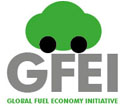
Access to priority lanes
Priority lanes
The benefit of special access to priority lanes - or specifically designated traffic lanes on roadways - is often two-fold: i) to allow public transport or high-occupancy vehicles to use such lanes to move passengers faster or ii) to incentivize the purchase of fuel efficient vehicles by allowing them access to the same lanes.
In some areas where high occupancy vehicle lanes exist, government officials have revised laws to permit owners of hybrid-electric cars to use such lanes with even only one occupant in the vehicle. In congested cities, this is a strong incentive for people to buy hybrid-electric vehicles as it cuts down on travel time and idling.
Ontario, Canada
The government of Ontario is promoting the use of electric vehicles by offering new, "green" license plates which allows electric vehicles access to carpool (or high occupancy) lanes, even if there is only one person in the vehicle.
U.S.
Permission for fuel efficient vehicles on priority lanes is handled by state governments and vary from state to state. Certain states (e.g., New York, California, Virginia, and Florida) allow singly-occupied HEVs to enter the high occupancy lanes on the highway.
The state of Virginia did allow hybrid electric vehicles to use the main high occupancy vehicle lanes from Virginia into the District of Columbia, but this exception was revoked when so many people bought hybrids to avoid traffic jams, that the lanes became overcrowded. There was no control on the number of hybrids that could use the lanes.
The Colorado Department of Transportation's (CDOT) hybrid vehicle program allows owners of qualifying hybrid electric vehicles to apply for a permit to use high occupancy lanes and preferential toll lanes. Qualifying vehicles must display the required exemption identifier. Initially, only 2000 permits were issued and the program was monitored to ensure minimal impacts to public service vehicles.
The text above is a summary and synthesis of the following documents:







